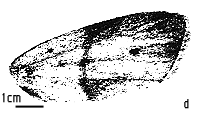|
Stictane
parvipectinata sp.
n.

Stictane
parvipectinata 
(holotype)
(x 1.63)

Fig.9d: Stictane parvipectinata sp.n.
holotype
|
 |
 |
  , ,
 6-7mm.
This is the largest Bornean species. The male antennae are narrowly bipectinate,
the rami much shorter than in bipunctulata
or umbrata. The forewings are
relatively uniform grey, perhaps slightly paler over the basal half anterior to
the narrow medial fascia which is slightly curved, concave distad. The discal
spot is strong, the subbasal ones moderate and the submarginal ones obscure. The
male genitalia are very similar to those of serrata except the valve apex is slightly broadened, with a
distinctive obtuse angle to its ventral margin distal to the saccular process.
The probable female has the appendix bursae reflexed, with an extensive zone of
scobination between it and the ductus; there is also a more distal group of
several longer spines. 6-7mm.
This is the largest Bornean species. The male antennae are narrowly bipectinate,
the rami much shorter than in bipunctulata
or umbrata. The forewings are
relatively uniform grey, perhaps slightly paler over the basal half anterior to
the narrow medial fascia which is slightly curved, concave distad. The discal
spot is strong, the subbasal ones moderate and the submarginal ones obscure. The
male genitalia are very similar to those of serrata except the valve apex is slightly broadened, with a
distinctive obtuse angle to its ventral margin distal to the saccular process.
The probable female has the appendix bursae reflexed, with an extensive zone of
scobination between it and the ductus; there is also a more distal group of
several longer spines.
Holotype
 . SARAWAK: Gunong Mulu Nat. Park, R.G.S. Exped. 1977-8 (J.D. Holloway
et al.), Site 26, April, G. Api Pinnacles, 1200m. 428545, open scrub, BM
arctiid slide 2667. . SARAWAK: Gunong Mulu Nat. Park, R.G.S. Exped. 1977-8 (J.D. Holloway
et al.), Site 26, April, G. Api Pinnacles, 1200m. 428545, open scrub, BM
arctiid slide 2667.
Paratypes:
3  (slide
4921), 3 (slide
4921), 3  (slide 4916) as
holotype. (slide 4916) as
holotype.
Geographical range. Borneo.
Habitat
preference. All
material was taken at 1200m near pinnacle karst on the limestone G. Api,
vegetated mainly with rather open montane scrub.
<<Back
>>Forward <<Return
to Contents page
|

